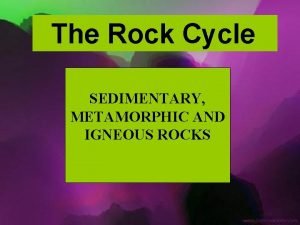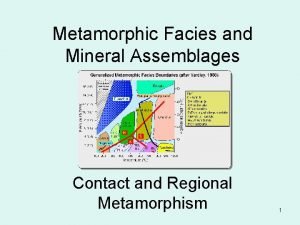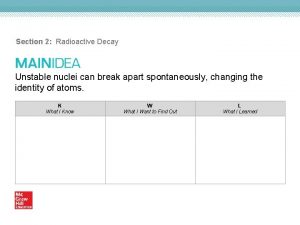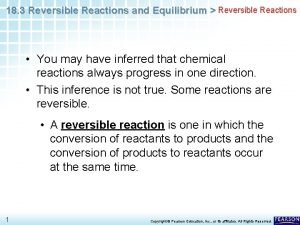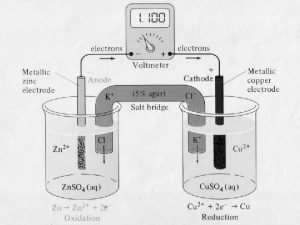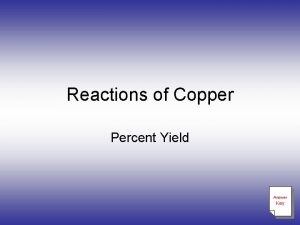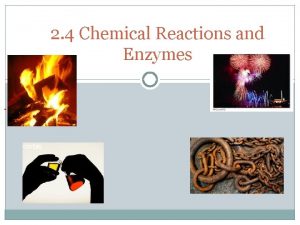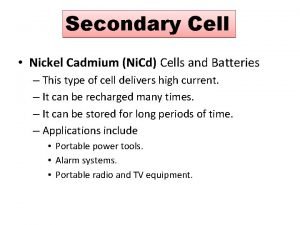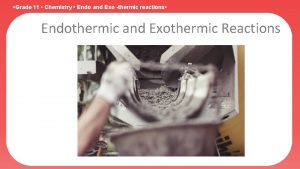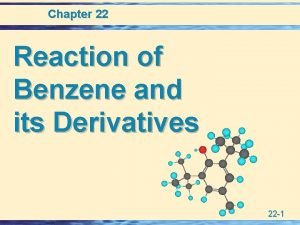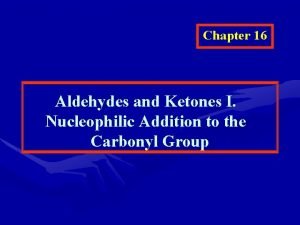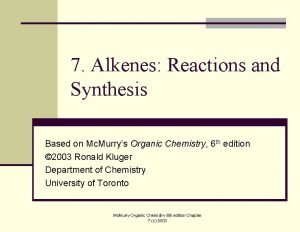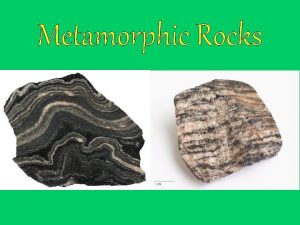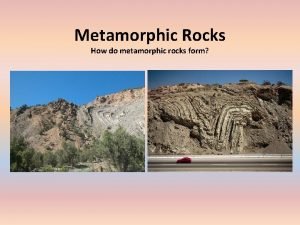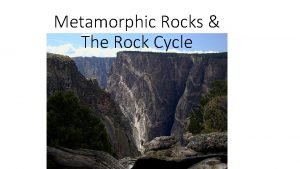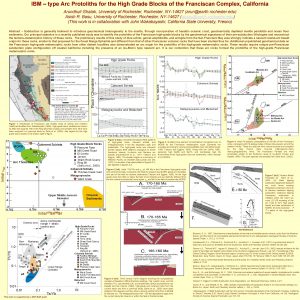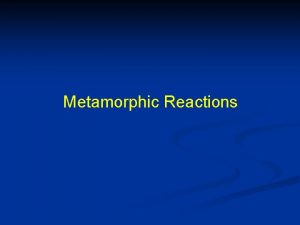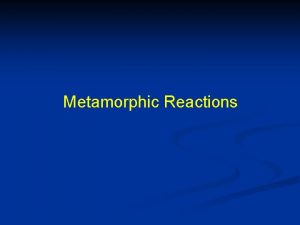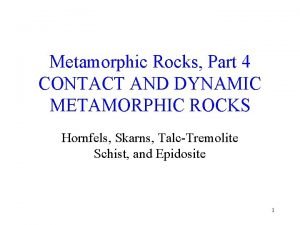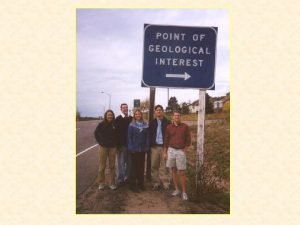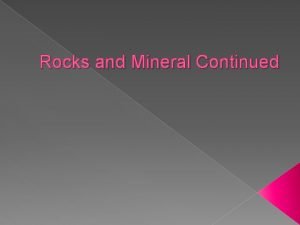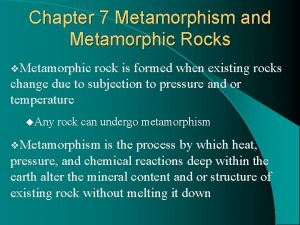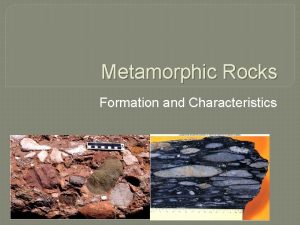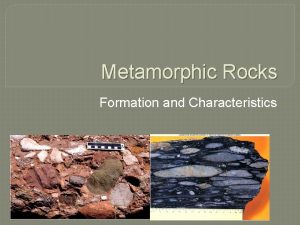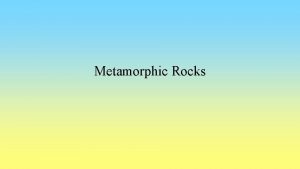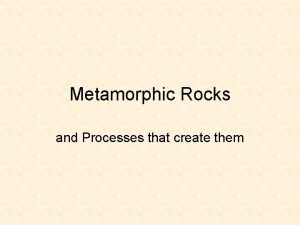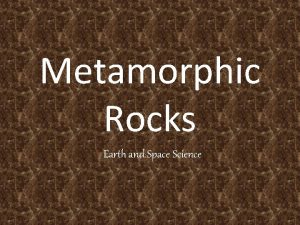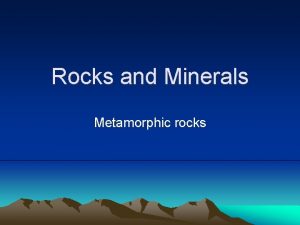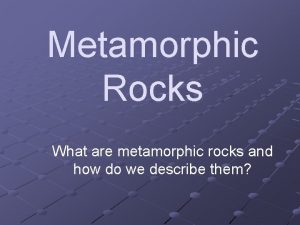Lecture FOUR Metamorphic Reactions and Protoliths of Metamorphic















































- Slides: 47

Lecture FOUR Metamorphic Reactions and Protoliths of Metamorphic Rocks

Development of Metamorphic Rocks The yielded metamorphic rocks, with specific mineral composition and textures is a function of: Protolith nature i. e: whole rock chemistry (pelitic (Argillaceous), semipelitic, calcareous (limestone and dolomite), mafic-ultramafic, basic igneous, granitic, Mn-rich sediments, ironstone, laterites. . . etc. ) P-T-X conditions (the intensity of temperature and the intensity and type of pressure (simple compressed or twisted and broken) influence and the presence or absence of fluids and their chemistry during metamorphism) Time (who long the rock subjected to HT and HP? . By which the grain size was evolved, and the reactions were proceed)


Metamorphic Rocks components and development A metamorphic rock consists of individual grains of several solid minerals and a network of grain boundaries, boundaries which at the time of metamorphism may have held an aqueous fluid, providing pathways for transport through the rock. garnet Omphacite

Development of Metamorphic minerals For a new mineral to appear by a chemical reaction, a number of processes have to operate in concern: Nucleation: nuclei (embryo crystals) of the new mineral appear Interface reactions - dissolution: reactant minerals break down, their chemical constituents going into solution Interface reactions - growth: material is added onto the nuclei to build larger crystals Mass transfer: material is transported through the rock from sites of breakdown to sites of growth

Nucleation, Mineral growth and Grain size -Completed reaction produces an amount of product (mineral phases). The microstructure, will depend on the relative rates of nucleation and growth of minerals - Grain size in a metamorphic rocks is a function in: - Intensity of P-T conditions, - nuclation rate, and -Time interval of metamorphism -Coarse-grained rocks are the product of long sustained metamorphic conditions (possibly over millions of years) at HT and HP (e. g. in high grade regional metamorphic rocks) -Fine-grained rocks are products of LP, LT, in some cases, short reaction time (e. g. in contact metamorphiic rocks)

Metamorphic Reactions and P-T path - With increasing P-T conditions, metamorphic reaction toke place (e. g. burial effect) until the maximum pressure and temperature (peak condition), then with decreasing the P-T conditions (e. g. uplift) until cooling of the rock. This is known as Metamorphic P-T path - The P-T path include three segments: Prograde segment: With increasing the P-T conditions (such as burial effect) Peak segment: at maximum PT conditions (at the summit metamorphic conditions) Retrograde segment: With decreasing P-T conditions (such as uplift) - The metamorphic P-T can be simple (clockwise or anticlockwise) or complex due to multiphase metamorphism

Types of Metamorphic reactions - With either progressing or retrogressing metamorphism, various types of metamorphic reactions are proceeds e. g. : 1 - Univarient reactions: reactions that plot as line or curve on the P-T diagram and depend on temperature and pressure only e. g: Al 2 Si 4 O 10(OH)2 Al 2 Si. O 5 + 3 Si. O 2 + H 2 O Pyrophyllite Al-silicate + Qtz + fluid

Cont. Types of Metamorphic reactions 2 - Divarient reactions: reactions occur over wide range of P-T. This because most minerals involved in the solution reaction (e. g plagioclase); exhibit garnet, therefore, solid mica, the reaction boundaries can changed depend on the composition of solid solution. KAl 2 Si 3 Al. O 10(OH)2 + Si. O 2 = KAl. Si 3 O 8 + Al 2 Si. O 5 + H 2 O Ms Qtz Kfs Sill W

Cont. Types of Metamorphic reactions 3 - Solid-soild reaction: only involve the solid-phases for both reactant and products (with no fluid phases). So reactions involves phase transformation e. g. Calcite aragonite, andalusite sillimanite, graphite diamond Albite jadite + quartz

Cont. Types of Metamorphic reactions 4 - Dehydration reactions: reactions that liberate H 2 O. This always occur in the prograde reaction, i. e. with increasing temperature e. g chlorite + muscovite orthoclase + andalusite + H 2 O 5 - Decabonation reaction : reactions that liberate CO 2 e. g Calcite + quartz Wallstonite + CO 2

Cont. Types of Metamorphic reactions 6 - Oxidation-reduction reaction: reactions that involve change the valence state of Fe-Ti oxide phases (Fe+2 and Fe+3) e. g: the breakdown of biotite to K-feldspars and magnetite at high P-T cinditions biotite + O 2 K-feldspars + Magnetite + H 2 O 7 - Cation exchange reaction: reaction involves ionic substitution of two or more phases in the system e. g: Fe-garnet + Mg-biotite + Fe-garnet 8 - Ionic reactions: reaction that balanced by inferring involvement of ionic species derived from the fluid phase

Protoliths of metamorphic rocks As we discuss, The yielded metamorphic rocks is function of: - Protolith (original rock) nature bulk-rock chemistry - P (pressure)-T (temperature)-X (active fluids) conditions - Time At specific P-T-X conditions, reactions in solid state toke place in the rock and new equilibrated mineral assemblage and corresponding textures are arise, which equivalent to the influence metamorphic conditions.

Protoliths of metamorphic rocks The protoliths of the metamorphic rocks could be: -Sedimentary rocks -Shales (Pelitic rocks) -Sandstones (Arenaceous rocks and semipelitic rocks) -Carbonate (Calcareous rocks) -marl rocks - Igneous rocks - Basic igneous rocks (metabasites) - Ultramafic rocks - Granitoid rocks - Prior metamorphic rocks

Metapelites Shales (Pelites): very fine-grained sedimentary rocks, composed of silicate clay minerals rich in the elements (Si. O 2, Al 2 O 3, Fe. O, K 2 O, Na 2 O, H 2 O), beside other minor elements. - Common metamorphic minerals include - Quartz - Feldspars (plagioclase, K-feldspars) - Mica (sericite, muscovite, biotite, chlorite) - garnet, - staurolite, - cordierite, - Al-silicate (andalusite, kyanite, silliminite) - Pyroxene


Quartz

Orthoclase

Perthite

Microcline

Plagiocalse

Chlorite

Muscovite

Biotite

Garnet Group

Staurolite

Al-silicates

Andalusite

Kyanite

1. Sillimanite (C)

Cordierite

Orthopyroxene

Metacarbonate rocks Limestone and dolomite (Calcareous rocks), composed essentially of calcite (Ca. CO 3), doilomite (Ca. Mg(CO 3)2, with minor quartz and clay minerals. If the clay minerals are excess, the rock known as marl - the yielded rocks is known as Marble (mainly calcite) if the calcareous rocks are pure. In case of non-pure calcareous rocks, marble contain silicate minerals such as: wollastonite, grossular-andradite garnet, diopside and tremolite

(a) Limestone (fiossiliferous)

Calcite (Ca. CO 3)

Anthophyllite

Metamorphosed sandstone Sandstones (Arenaceous rocks): of variable composition, arenite (wholly quartz), arkose (quartz + feldspars) and graywackes (quartz, lithic fragment and clayey matrix) -Metamorphism of sandstone yield gneisses (quartz + plagioclase + K-feldspars + biotite + granet + Fe-Ti oxides) - Metamorphism of graywackes formed a metamorphic rocks intermediate between metapelites and gneisses) - Arenites yield quartizites

Quartz Sandstone

Metamorphosed basic igneous rocks Basic rocks including basalts and gabbros, are low silica igneous rocks that contain plagioclase and pyroxene. - Metamorphism of basic igneous rocks yielded metabasites (quartz, plagioclase, amphiboles, garnet, epidotes, chlorite) - If the rock is composed of plagioclase and amphibole, amphibolites term are used - At extreme P-T conditions, Eclogites are formed (garnet + omphacite)

CPX: Diopside - Augite

Omphacite

Tremolite-actinolite

Hornblende

Glucophane

Metamorphosed Ultramafic rocks, Mg-Fe rich silicate minerals (Diopside, Olivine) -When metamorphosed yielded produce serpentinites and talc schists with mineral assemblage include serpentine minerals, talc, enstatite, diopside, anthophyllite, tremolite, hornblende, garnets and chlorite

Serpentine

Talc
 Section 2 classifying chemical reactions worksheet answers
Section 2 classifying chemical reactions worksheet answers 5 examples of redox reaction
5 examples of redox reaction Section 2 classifying chemical reactions
Section 2 classifying chemical reactions Types of reactions
Types of reactions Chemistry unit 5 reactions balancing reactions worksheet
Chemistry unit 5 reactions balancing reactions worksheet 01:640:244 lecture notes - lecture 15: plat, idah, farad
01:640:244 lecture notes - lecture 15: plat, idah, farad Four types of chemical reactions
Four types of chemical reactions Four types of chemical reactions
Four types of chemical reactions Shape with four sides
Shape with four sides Four eyes skin assessment
Four eyes skin assessment Igneous metamorphic sedimentary
Igneous metamorphic sedimentary Igneous sedimentary and metamorphic
Igneous sedimentary and metamorphic Igneous metamorphic sedimentary
Igneous metamorphic sedimentary Parent rock
Parent rock Metamorphic facies
Metamorphic facies Chapter 6 sedimentary and metamorphic rocks answer key
Chapter 6 sedimentary and metamorphic rocks answer key What do a butterfly and metamorphic rock have in common
What do a butterfly and metamorphic rock have in common Concept map of metamorphic rocks
Concept map of metamorphic rocks Metamorphic grade
Metamorphic grade Parent rock of granite
Parent rock of granite Ciclo de rocas
Ciclo de rocas Nuclear decays and reactions section 2
Nuclear decays and reactions section 2 Reversible and irreversible reactions
Reversible and irreversible reactions Oxidation meaning in chemistry
Oxidation meaning in chemistry Spontaneity of redox reactions
Spontaneity of redox reactions Reactants and products
Reactants and products Chemistry chapter 8 review chemical equations and reactions
Chemistry chapter 8 review chemical equations and reactions Chapter 8 section 1 chemical equations and reactions
Chapter 8 section 1 chemical equations and reactions Balancing equations chapter 8
Balancing equations chapter 8 Section 2-4 chemical reactions and enzymes
Section 2-4 chemical reactions and enzymes Aqueous reactions and solution stoichiometry
Aqueous reactions and solution stoichiometry Reversible reactions
Reversible reactions Galvanic cells
Galvanic cells Hcl and sodium hydrogen carbonate
Hcl and sodium hydrogen carbonate Types of chemical reactions and solution stoichiometry
Types of chemical reactions and solution stoichiometry Chemsheets reactions of alcohols 1 answers
Chemsheets reactions of alcohols 1 answers Unit 5 chemical equations and reactions
Unit 5 chemical equations and reactions Types of chemical reactions and solution stoichiometry
Types of chemical reactions and solution stoichiometry The age of exploration outcome china and japan's reactions
The age of exploration outcome china and japan's reactions The age of exploration outcome china and japan's reactions
The age of exploration outcome china and japan's reactions Answer key
Answer key What is released or absorbed whenever chemical
What is released or absorbed whenever chemical Nickel cadmium cell primary secondary
Nickel cadmium cell primary secondary Endothermic and exothermic reactions grade 11
Endothermic and exothermic reactions grade 11 Is no2 para or meta directing
Is no2 para or meta directing Aldehyde protecting group
Aldehyde protecting group Diol formation from alkene
Diol formation from alkene Reactivity series and displacement reactions
Reactivity series and displacement reactions











